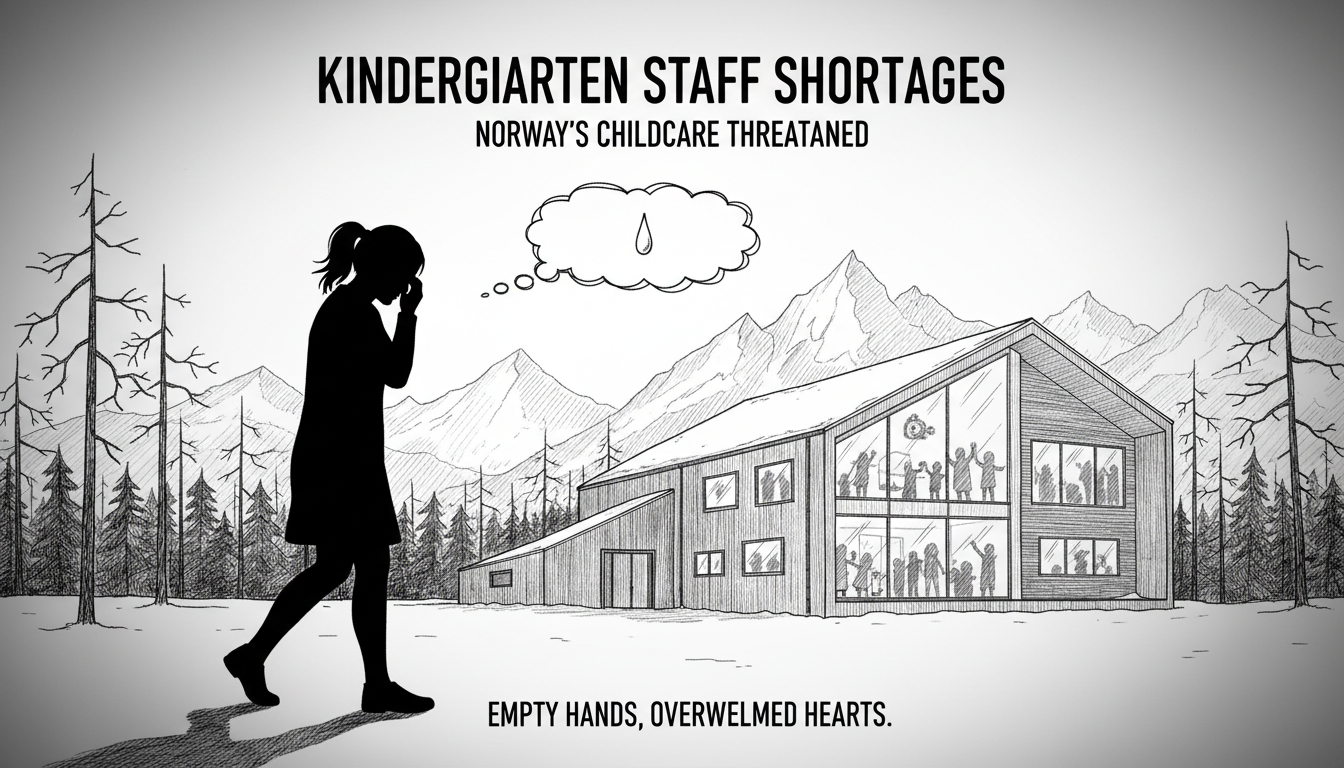Kindergarten Staff Shortages Threaten Norway's Childcare System
Norway faces a kindergarten staffing crisis as applications plummet and experienced educators struggle with overwhelming demands. Veteran teacher Kari Herefoss describes crying on her way home from work, unable to provide adequate attention to all children. Without intervention, experts warn kindergartens could become mere storage facilities rather than developmental environments.

Experienced educator Kari Herefoss has watched preschools change dramatically over her 33-year career. Children start younger now. All children, including those with special needs, attend the same facilities. Documentation requirements have multiplied.
Yet resources haven't kept pace with these growing demands, according to Herefoss.
She sits on the floor at Eilert Sundt SiO kindergarten in Oslo's Blindern district, glitter on her face, guiding older children through imaginative building projects. Despite increasing pressure on staff, Norway faces worsening shortages of qualified kindergarten teachers.
First-quarter sick leave data from 2015-2025 shows concerning trends among childcare workers.
Herefoss contrasts today's situation with her early career days. 'When I started, children with social challenges had full-time assistants. Now we struggle to get just a few hours of support weekly,' she explained.
Basic staffing levels now must cover everything, she says. This creates particular strain in departments with multiple children needing extra attention.
'I often feel I'm not enough. It's painful. Sometimes I cry on my way home because I couldn't be there sufficiently for all the children,' Herefoss shared.
During the COVID-19 pandemic, Herefoss hit a wall and joined the high sick leave statistics. Returning made her realize the fight was worth it. Giving up would mean abandoning her passion.
She constantly reminds herself that the good outweighs the difficult. 'But too many voices now focus on how tough kindergarten work is. We need to tell a new story about ourselves and this profession,' she urged.
If application numbers keep declining, Herefoss fears kindergartens will rely on temporary staff lacking qualifications. Facilities could become mere storage spaces rather than developmental environments.
Her advice to prospective teachers? 'All workplaces differ. If you don't thrive in your first job, find another kindergarten.'
As pedagogical leaders, educators must stand firm amid competing demands from parents, children and colleagues. 'Take bread crusts - there are a hundred opinions about them, right? You decide your department's approach,' she noted.
Building that confidence takes time. Many new graduates struggle with this transition.
Herefoss emphasizes that Norway must increase investment in early childhood education. She advocates for higher basic staffing levels or smaller groups. 'But we cannot give up on our children. We must fight for our profession,' she insisted.
To retain experienced staff, she proposes a 'wear and tear allowance' for older workers and special retirement age limits acknowledging the profession's physical demands.
'In kindergarten, you endure noise and sudden changes requiring constant adaptation - often multiple times daily,' she described.
This becomes harder with age. Herefoss has many colleagues who are partially disabled after years in the job. 'Kindergarten is my life. But I see myself lasting until 64 at most. Never to 70... That's utopian,' she admitted.
Throughout her career at Student Welfare Organization kindergartens in Oslo, Herefoss's employer has shared her core value: play should remain central.
This explains her passion. 'All children deserve encounters with adults genuinely interested in who they are. Our future depends on children having good experiences that build lifelong self-confidence,' she emphasized.
In our stimulus-heavy world, kindergartens provide something crucial, she believes. 'During play, children enter flow states. They forget their surroundings and don't feel pressured to constantly move to something new. They exist here and now. This benefits stress hormones and everything else.'
Lars Gulbrandsen at NOVA research institute currently leads a project investigating staff retention in kindergartens. Stability was good until the pandemic, but something has shifted since. Research hasn't yet explained why.
Gulbrandsen notes one clear finding: workplace-based education candidates comprise a growing proportion of new kindergarten teachers. Almost none of them quit.
'They're more stable because they know what they're getting into, unlike those coming straight from high school,' he explained.
Union leader Maren Oddvang from the Children and Upbringing Federation in Oslo is blunt about the core problem: 'There are already too few staff in kindergartens.'
Applications for child and youth worker vocational programs have declined since 2020. Fewer candidates complete these qualifications yearly.
The union's latest member survey showed 65% of kindergarten assistants believe staffing is too low for proper work. Nearly as many child and youth workers agreed.
'We have staffing norms, but they're treated as maximums rather than minimums. Staff can only do what's absolutely necessary,' Oddvang stated.
The union demands higher staffing requirements applied throughout opening hours at department level. This means more staff working simultaneously with children.
Norway's parliamentary-mandated kindergarten staffing norms, established in 2018, require one staff member per three children under three, and one per six older children.
These are paper requirements - if a kindergarten has sufficient annual work hours distributed across children, it meets the norm.
Nearly all Norwegian kindergartens meet the norm on paper. Little documentation exists about actual staff presence with children throughout the day.
The staffing crisis reflects a fundamental undervaluing of early childhood education despite its proven importance. When qualified professionals leave because they cannot provide quality care, everyone loses.